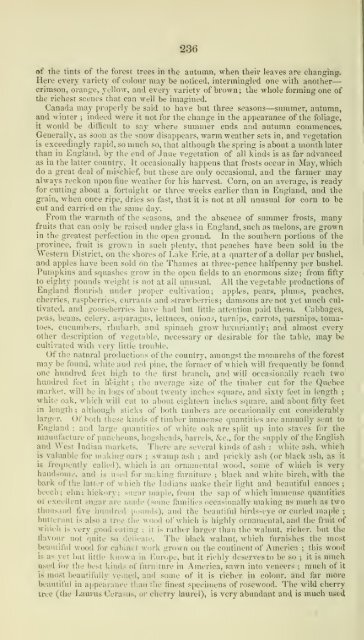Smith's Canadian gazetteer - ElectricCanadian.com
Smith's Canadian gazetteer - ElectricCanadian.com
Smith's Canadian gazetteer - ElectricCanadian.com
You also want an ePaper? Increase the reach of your titles
YUMPU automatically turns print PDFs into web optimized ePapers that Google loves.
—<br />
236<br />
of the tints of the forest trees in the autumn, when their leaves are changing.<br />
Here every variety of colour may be noticed, intermingled one with another<br />
crimson, orange, yellow, and every variety of brown ; the whole forming one of<br />
the richest scenes that can well be imagined.<br />
Canada may properly be said to have but three seasons—summer, autumn,<br />
and winter ;<br />
indeed were it not for the change in the appearance of the foliage,<br />
it would be difficult to say where summer ends and autumn <strong>com</strong>mences.<br />
Generally, as soon as the snow disappears, warm weather sets in, and vegetation<br />
is exceedingly rapid, so much so, that although the spring is about a month later<br />
than in England, by the end of Juue vegetation of all kinds is as far advanced<br />
as in the latter country. It occasionally happens that frosts occur in May, which<br />
do a great deal of mischief, but these are only occasional, and the farmer may<br />
always reckon upon fine weather for his harvest. Corn, on an average, is ready<br />
for cutting about a fortnight or three weeks earlier than in England, and the<br />
grain, when once ripe, dries so fast, that it is not at all unusual for corn to be<br />
cut and carried on the same day.<br />
From the warmth of the seasons, and the absence of summer frosts, many<br />
fruits that can only be raised under glass in England, such as melons, are grown<br />
in the greatest perfection in the open ground. In the southern portions of the<br />
province, fruit is grown in such plenty, that peaches have been sold in the<br />
Western District, on t!ie shores of Lake Erie, at a quarter of a dollar per bushel,<br />
and apples have been sold on the Thames at three-pence halfpenny per bushel.<br />
Pumpkins and squashes grow in the open fields to an enormous size; from fifty<br />
to eighty pounds weight is not at all unusual. All the vegetable productions of<br />
England flourish under proper cultivation; apples, pears, plums, peaches,<br />
cherries, raspberries, currants and strawberries; damsons are not yet much cultivated,<br />
and gooseberries have had but little attention paid them. Cabbages,<br />
peas, beans, celery, asparagus, lettuces, onion, turnips, carrots, parsnips, tomatoes,<br />
cucumbers, rhubarb, and spinach grow luxuriantly; and almost every<br />
other description of vegetable, necessary or desirable for the table, may be<br />
cultivated with very little trouble.<br />
Of the natural productions of the country, amongst the monarchs of the forest<br />
may be found, white and red pine, the former of which will frequently be found<br />
one hundred feet high to the first branch, and will occasionally reach two<br />
hundred feet in hl4ght ; the average size of the timber cut for the Quebec<br />
market, will be in logs of about twenty inches square, and sixty feet in length ;<br />
white oak, which will cut to about eighteen inches square, and about fifty feet<br />
in length ; although sticks of both timbers are occasionally cut considerably<br />
larger. Of both these kinds of timber innnense quantities are annually sent to<br />
England ; and large quantities of white oak are split up into staves for the<br />
manufacture of puncheons, hogsheads, barrels, &c., for the supply of the English<br />
and West Indian markets. There are several kinds of ash : white ash, which<br />
is valuable for making oars ; swamp ash ; and prickly ash (or black ash, as it<br />
is frequently called), which is an ornamental wood, some of which is very<br />
handsome, and is used for making fnrnittu-e ; black and white birch, with the<br />
bark of the latter of which the Indians make their light and beautiful canoes ;<br />
beech; elm; hickory; sugar nuiple, from the sap of which immense quantities<br />
of excellent sugar are made (some families occasionally making as nmch as two<br />
thousand five hundred jwunds), and the beautiful birds-eye or curled maple ;<br />
butternut is also a tree tlie wood of which is highly ornamental, and the fruit of<br />
which is very good eating ; it is rather larger than the walnut, richer, but the<br />
flavour not quite so delicate. The black walnut, which furnishes the most<br />
beautiful wood for cabinet work grown on the continent of America ; this wood<br />
is as yet but little known in Europe, but it richly deserves to be so ; it is nmch<br />
used for the best kinds of furniture in America, sawn into veneers ; much of it<br />
is most beaixtifuily veined, and some of it is richer in colour, and far more<br />
beautiful in ajipearance than tlie finest specimens of rosewood. The wild cherry<br />
tree (the Laurus Cerasus, or cherry laurel), is very abundant and is much used

















